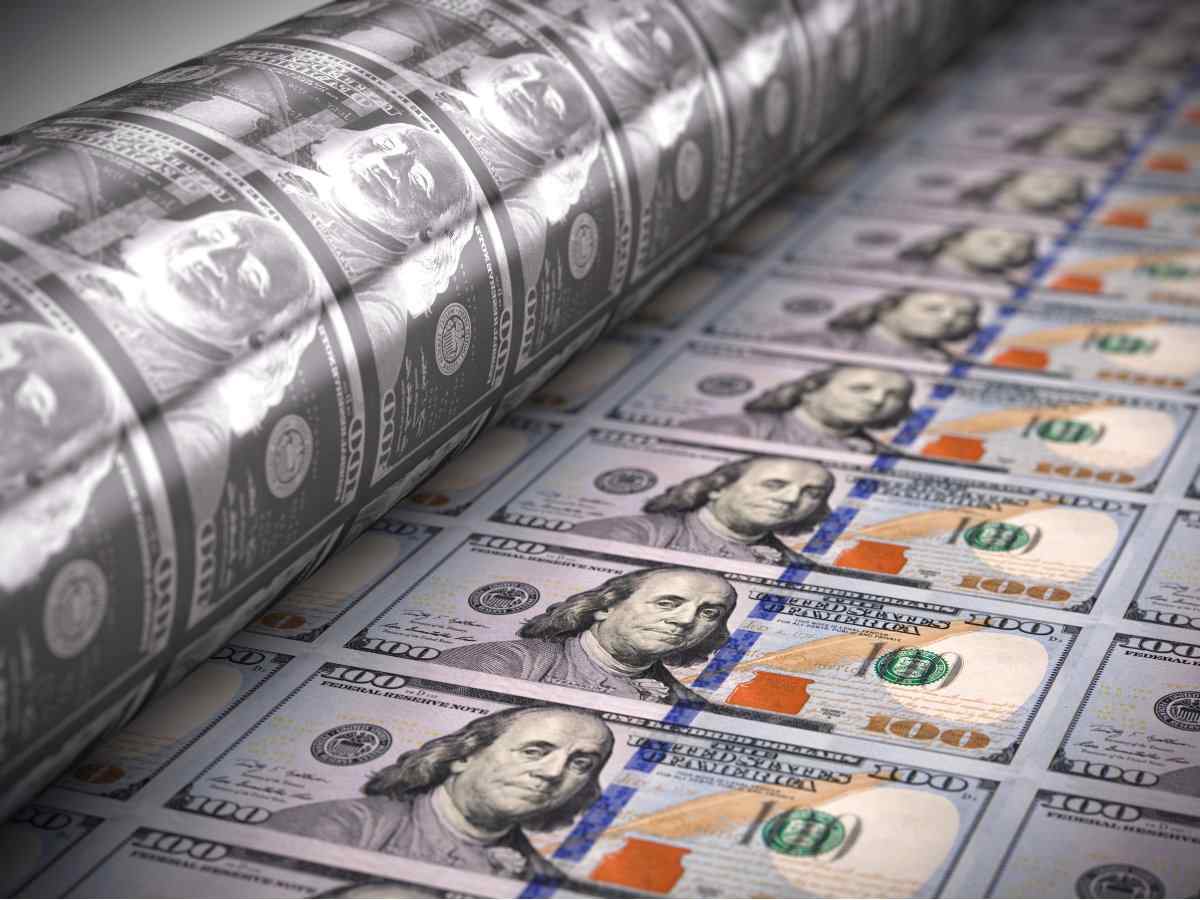How to Protect Yourself from Dollar Collapse
Recent, unexpected events like the pandemic have affected the U.S. economy. As a result, the inflation rate in the United States hit 6.2% in October 2021, the highest in over three years. Because of this, experts believe that we will witness never-before-seen inflation levels, which could ultimately lead to the devaluation of the U.S. Dollar.
While a complete economic shutdown is highly unlikely in the coming years, you can still learn how to protect yourself from a dollar collapse. This article will explain the scenarios in which the U.S. currency could depreciate and how to prepare for an American dollar collapse.
Reasons Why the Dollar Can Collapse
 Multiple reasons can collectively lead to a dollar collapse. These are the top five likely scenarios:
Multiple reasons can collectively lead to a dollar collapse. These are the top five likely scenarios:
Printing Money
At first glance, printing money out of thin air seems both easy and beneficial to society. However, sometimes the government has to print more money and inject it into the economy or give it out for free as a response to such emergencies as the pandemic. Consequently, producers sometimes increase the prices of consumer goods as the purchasing power of individuals increases. High inflation levels can lead to a significant devaluation of the U.S. currency. In December 2021, the United States witnessed its highest inflation rate in nearly four decades. The effects were seen in January 2022, when the greenback dropped by 0.7% against other major currencies.
Other Currency Alternatives
Currencies that could replace fiat money in the future are gaining more popularity. Even though such payment options as Bitcoin are still not widely used, some people believe that there is a possibility that their acceptance as a common currency could eventually replace the USD.
Economic Events
The pandemic, wars, and other unforeseen circumstances leave marks on the economy. For example, wars can make it difficult to import goods or cause higher tariffs. As a result, this can lead to increases in the price of goods or, in other words, inflation. Ultimately, any of these events could spark unfavorable consequences for the U.S. economy and make the dollar drop significantly.
U.S. Dollar Strengths
The U.S. Dollar is one of the world’s most stable currencies, mainly due to trust from the international community. Here are several reasons why the USD is currently so powerful and influential in the world:
- It is the largest reserve currency in the world. A reserve currency is a large amount of cash held by central banks and major financial institutions and used for international transactions. About 61% of the total international foreign currency reserves are in USD, making it easier for the United States to trade with other nations.
- Many countries peg their currencies to the U.S. Dollar. When a particular country sets a specific exchange rate of its national currency to the dollar, it shows how dependent its economy is on the American currency and how it could suffer from the fall of the dollar.
- When the U.S. Dollar appreciates against other currencies, import and international travel become cheaper.
U.S. Dollar Weaknesses
 These are the main weaknesses of the greenback:
These are the main weaknesses of the greenback:
- The dollar exists only through government fiat and is no longer backed by gold. As a result, there is no physical asset with intrinsic value to maintain the buying power of the U.S. currency.
- Several currencies, including the euro and the Japanese yen, have recently gained reserve currency status. This ongoing trend can negatively affect the value of the U.S. Dollar by diminishing international dependence and usage.
- The USD is a centralized currency. This means that certain intermediaries are needed to transfer funds, and buyers and sellers usually need to pay fees to complete these transactions. Unlike alternative payment options, such as Bitcoin, which is more decentralized, transfers in USD usually take time and may be less secure.
When Will the Dollar Collapse?
In reality, a dollar collapse could happen at any time. Luckily, economic shutdowns have occurred in the past, so people more or less know what happens if the dollar crashes. Historically, world economies have eventually recovered from these downturns, although it has taken several years.
This is not to say that you should not be prepared for a possible doomsday. There are multiple ways to protect yourself from U.S. Dollar collapse. However, no one can predict precisely what will happen if the greenback depreciates. Below we list some possible scenarios but keep in mind that these are simply assumptions based on historical data.
What Would Happen If the Dollar Collapsed?
A dollar collapse could lead to a colossal economic crash in the U.S. and the world. As a result, people would try to protect their assets by diversifying their portfolios and investing in more stable asset classes, such as gold. Consequently, the demand for Treasuries would likely decline, and interest rates would rise.
Conversely to dollar appreciation, dollar depreciation would lead to an increase in import prices. The U.S. government would most likely respond by releasing more money into circulation. As we already mentioned above, this would, in its turn, lead to a sharp increase in the prices of consumer goods.
How to Protect Yourself from Dollar Collapse
We all learn that saving money for emergencies can help if an emergency happens, which is true. However, if all your savings are in cash and we witness a dollar value decrease, your savings won’t have the same purchasing power as before. That said, here are a few tips we suggest you follow to protect yourself from dollar collapse.
Diversify Your Assets
One of the best ways to protect your assets is to diversify them. Spreading your investments over different asset classes may not prevent economic downturns from occurring, but it can certainly reduce their negative impact. These are some ideas of where to invest before the dollar collapses:
Gold

Gold is a perfect example of what to own when the dollar collapses. Even during economic recessions, the value of gold remained relatively stable. The price of gold is tied to the intrinsic value of the tangible asset and has increased by 250% over the past 20 years. Moreover, the price of gold has historically had an inverse relationship with the stock market. Typically, when stock prices decrease, the value of gold mainly increases.
Federal Bond Funds
U.S. Treasury bonds are a low-risk investment because they are backed by the full faith and credit of the government. Additionally, fixed interest rates and long-term maturation make these bonds a popular choice for risk-averse investors. Investors often enjoy semiannual dividends.
Bitcoin
Bitcoin was introduced about a decade ago as an alternative payment method that is not regulated by a central bank. Even though it’s still in its infancy, Bitcoin’s price grew from a few cents to a record-high of $64,800 per coin in 2021. Bitcoin can be a great hedge against inflation due to its limited availability and high demand. Unlike fiat money that loses value as more is printed, Bitcoin will always remain in limited supply. As a result, the price will continue to rise as less of the asset becomes available.
Real Estate
 Think about how people would still need a home whatever happens to the economy. The demand for housing has relatively been stable, making real estate one of the lowest-risk asset classes you could invest in. Buying a property at a fixed rate and renting it out can be a reliable source of passive income. Additionally, it can also benefit you if the rental prices increase in relation to mortgage rates.
Think about how people would still need a home whatever happens to the economy. The demand for housing has relatively been stable, making real estate one of the lowest-risk asset classes you could invest in. Buying a property at a fixed rate and renting it out can be a reliable source of passive income. Additionally, it can also benefit you if the rental prices increase in relation to mortgage rates.
Buy Using the DCA Strategy
Through the Dollar Cost Averaging (DCA) strategy, small amounts of money are invested in a specific asset class over a long period of time. By investing a lump sum of money at once, you may risk buying the asset at a peak price. Instead, investing small amounts over a longer period may help you spend less and maximize your return. Even though this strategy requires time and patience to witness the end goal, it is still a great way to avoid dollar volatility.
Here’s an example to showcase this strategy. Let’s say you have invested $10 per week in Bitcoin over the last four years, which totals $26,100 of investment. Your holdings would be worth $163,849 as of Bitcoin’s price today, March 9, 2022. As a result, your return on investment would approximately be 528%.
Pay Off Debt
 Often, unexpected expenses may necessitate short-term loans. As a result, incurring debt may not always be avoidable. However, it is best to exhaust all your options before resorting to loans. This is because a possible dollar collapse could make repayment more difficult for borrowers.
Often, unexpected expenses may necessitate short-term loans. As a result, incurring debt may not always be avoidable. However, it is best to exhaust all your options before resorting to loans. This is because a possible dollar collapse could make repayment more difficult for borrowers.
First, try to pay loans with shorter terms or higher interest rates. If you have multiple loans with varying interest rates and due dates, you may consider consolidating your debts. This allows you to roll over your outstanding loans into a larger-sum loan. In turn, you’ll have one due date and may receive a lower interest rate.
Final Thoughts
To wrap up, it’s highly unlikely that the U.S. Dollar will collapse, at least in the near future. However, even though the U.S. greenback is one of the most stable currencies in the world, you should still proactively minimize the effects of a possible dollar collapse.
To protect yourself from dollar collapse, start by diversifying your portfolio into multiple asset classes, and if you’re in debt, pay them back as soon as possible.
Keep in mind that this article shouldn’t be considered as financial advice. We have shared this information to give you a general idea of the consequences of the American dollar collapse. For further information, please contact a professional in the field.





